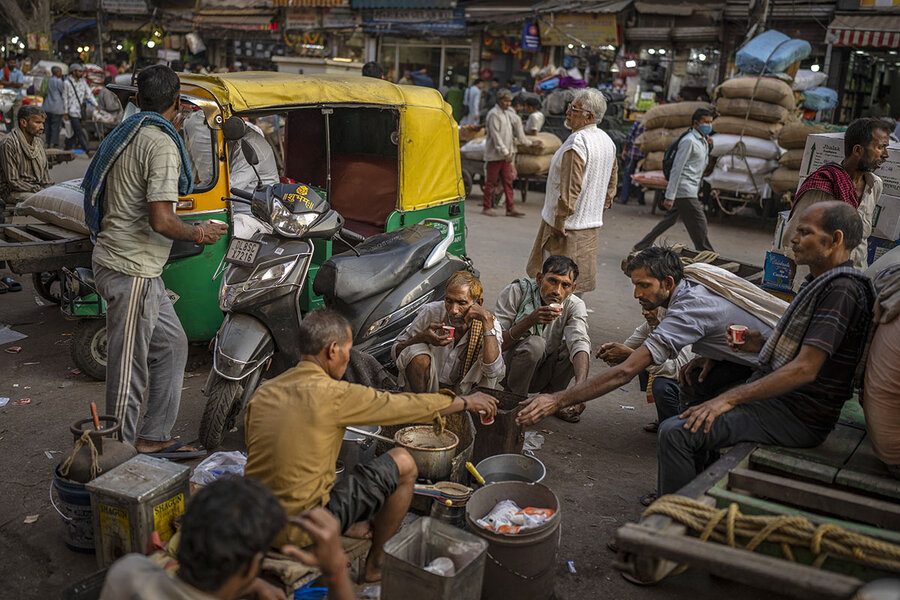Mental health or labor crisis? India’s suicide data points to both.
Loading...
| New Delhi
India’s suicide data is massively underreported, and yet the country accounts for the highest number of suicide deaths in the world. When the National Crime Records Bureau recently released its 2021 data, two things stood out – the suicide rate was at an all-time high, and 1 of every 4 persons who died by suicide was a daily wage earner.
Experts say the situation is “alarming,” but for those working in the labor sector, “it did not come as a surprise,” says Divya Varma, who leads knowledge and policy advocacy at Aajeevika Bureau, a nonprofit working with migrant worker communities. It was a stark reminder of the continued social, economic, and mental toll of COVID-19 on marginalized groups.
“The trauma that we saw on the ground, it got manifested in numbers,” she adds.
Why We Wrote This
A story focused onWhile many countries avoided the predicted uptick in suicides during the pandemic, new data shows India’s toll rose in both 2020 and 2021. Experts say the deaths point to an urgent need for a more holistic suicide prevention strategy.
What are key takeaways from the new data?
Contrary to predictions, most countries did not experience a significant uptick in suicide deaths during COVID-19. India, however, recorded 164,033 deaths by suicide in 2021, an increase of more than 7% from 2020, which saw a 10% jump from the year before.
“Illness” and “family problems” were cited as the main drivers of suicide deaths last year. But when we look at the data by other parameters – high suicide deaths among middle-aged men, those who are self-employed, and daily wage earners – we may actually be seeing the results of economic pressure “that affects an individual at all levels and has an impact on their interpersonal relationships,” says Dr. Lakshmi Vijayakumar, a psychiatrist and founder of the Chennai-based suicide prevention nonprofit SNEHA.
India has been facing a massive job and unemployment crisis. For many at the bottom rung of the increasingly informal workforce, COVID-19 served as a tipping point, says Ms. Varma. Denial of fair wages, mounting debt, and lack of means for redress left workers deeply stressed and likely contributed to the increase in suicides, she adds.
At the same time, the suicide rate among women and girls in India remains twice the global rate, with housewives being the profession most affected after daily wage earners.
How has the government responded to the suicide crisis?
India has been hailed in recent years for attempting to shift the government’s role in suicide prevention from one of punishment to support, but barriers to progress remain. The Mental Healthcare Act in 2017 largely decriminalized suicide attempts, yet India’s British-era penal code still treats suicide as a crime, and Dr. Vijayakumar says such legal anomalies lead to continued harassment and stigma for survivors.
The act also called for the availability of mental health services in every district, but there has been a severe lack of implementation, says Priti Sridhar, chief executive officer at Mariwala Health Initiative, a mental health funding and advocacy organization.
Yet for a crisis of the magnitude in India, providing mental health services may not be enough.
A growing amount of research highlights the need to veer away from looking at suicide through the lens of individual health and to acknowledge it as a broader societal issue, Ms. Sridhar says.
How can India better support vulnerable communities?
Dr. Vijayakumar – who in 2018 was part of a government task force that put together a national suicide prevention strategy, which has yet to be implemented – says India’s suicide crisis cannot be addressed by the health department alone. It requires involvement from multiple sectors, “and that can only be possible if we have a strong coordinating body or a national strategy,” she adds.
Until then, some initiatives have sought to address the challenges workers face. Aajeevika Bureau and Working People’s Charter launched India Labourline, a national hotline that helps settle wage disputes and address rights violations by mediating with employers or contractors on workers’ behalf. An intervention model like this can be easily scaled with government support, say experts.
Some say suicide prevention is achievable without requiring huge financial and other resource investments. It can entail, for instance, training India’s existing network of community workers to identify and prevent suicides in the last mile.
“Most people who are suicidal are ambivalent,” says Dr. Vijayakumar. “Their wish to live and their wish to die is like a seesaw battle for them. So at that moment if some support is given, many suicides can be prevented.”





